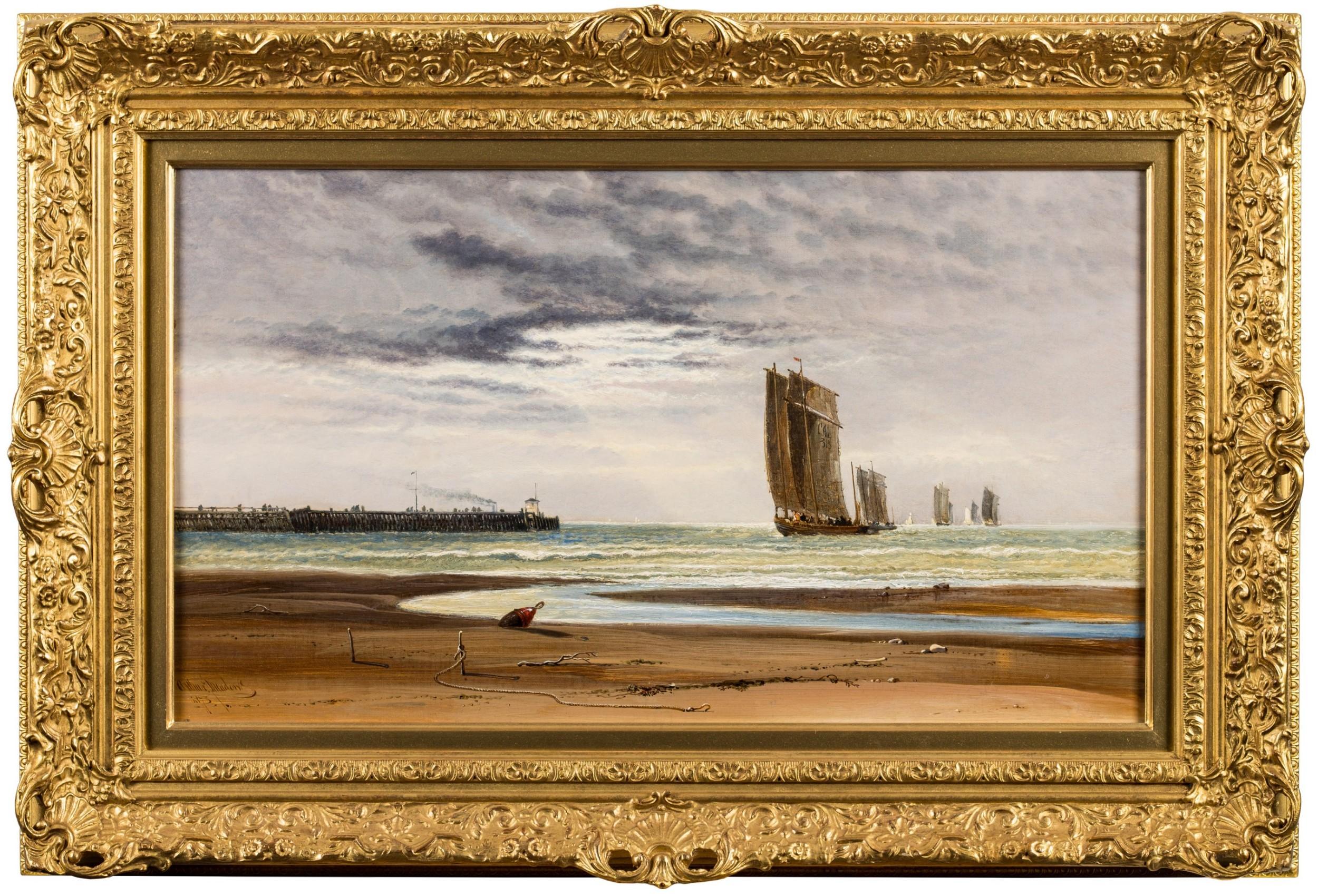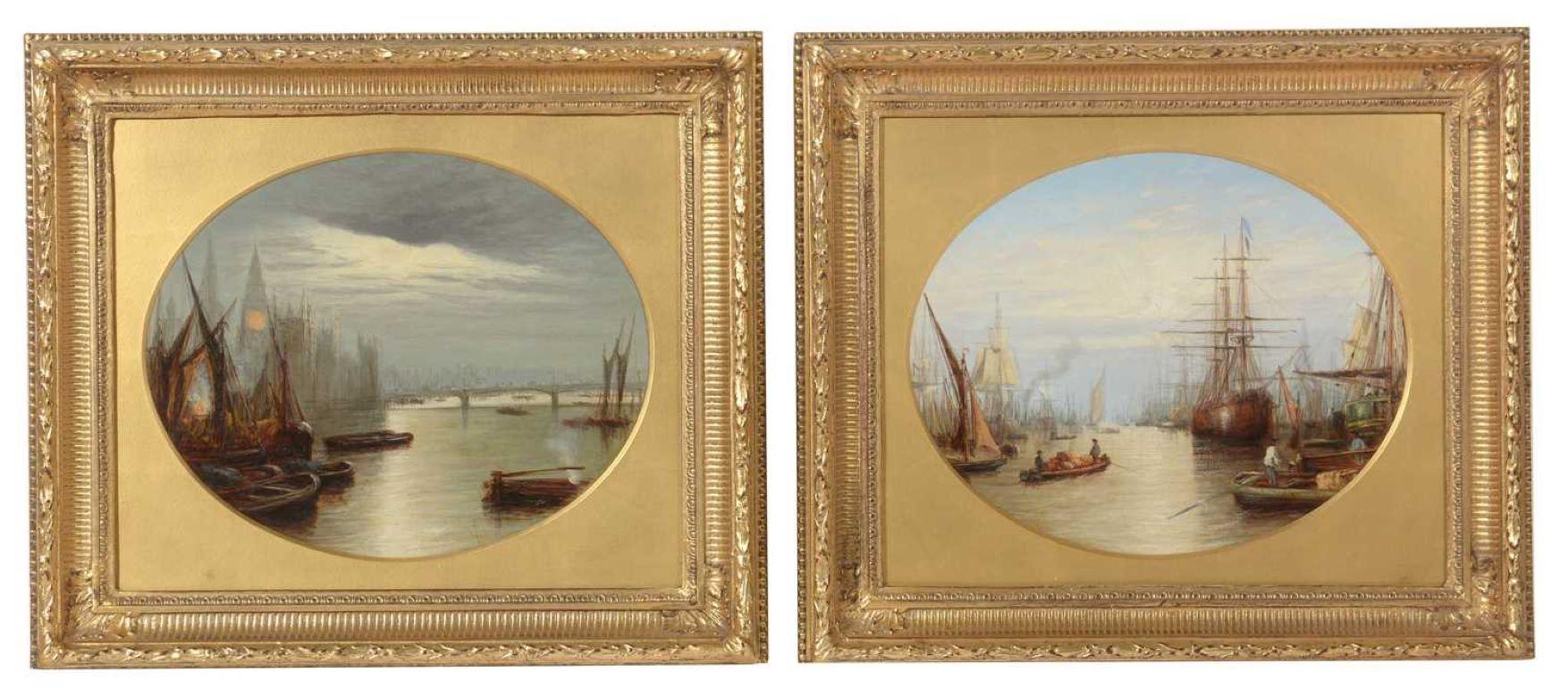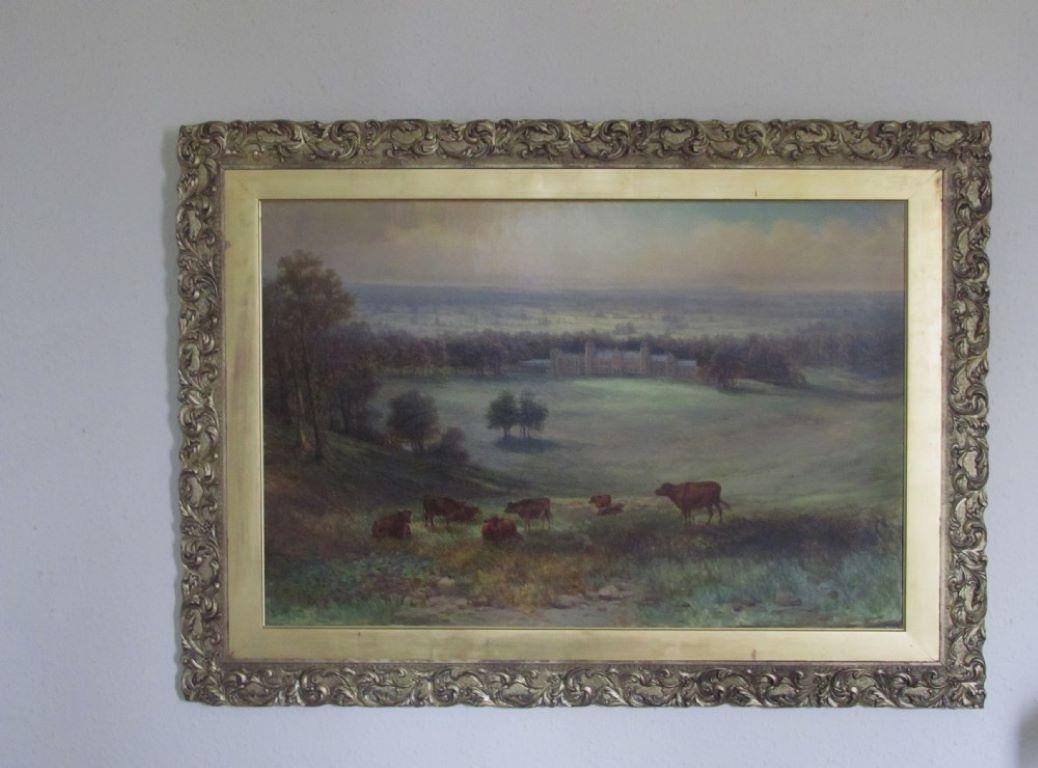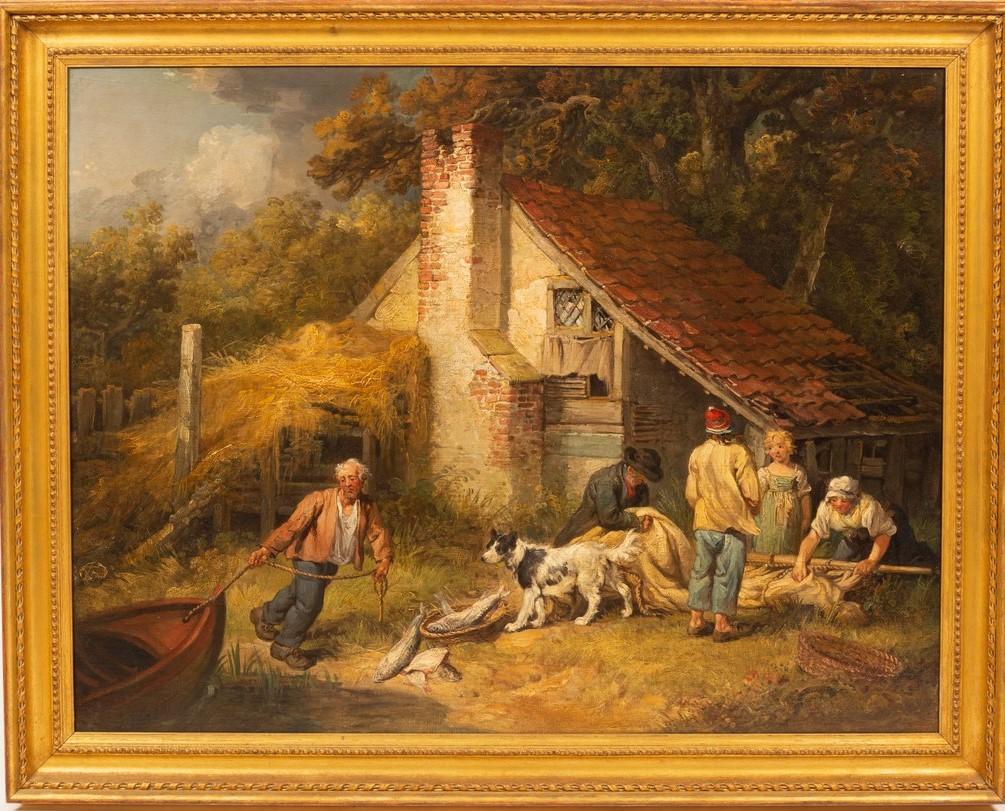Items Similar to View Venice See Giudecca Guardi 18/19th Century Paint Oil on canvas Old master
Want more images or videos?
Request additional images or videos from the seller
1 of 13
View Venice See Giudecca Guardi 18/19th Century Paint Oil on canvas Old master1780-1820
1780-1820
About the Item
Giacomo Guardi (Venice, 1764 - Venice, 1835)
View of Venice with the Giudecca Canal and the Gesuati Church
oil on canvas
34 x 42 cm. - framed 40 x 50 cm.
Expertise dott Federica Spadotto
The beautiful view of Venice elects the church of Santa Maria del Rosario, known to Venetians as the Gesuati, built on the Giudecca Canal by Giorgio Massari between 1724 and 1736, as the protagonist of the representation.
It is a painting by Giacomo Guardi (Venice, 1764 - Venice, 1835), son and pupil of the well-known Vedutista Francesco Guardi, who continued his father's activity by painting many views and capriccios.
His production boasts especially small-format compositions because they were intended to meet the demands of collectors and refined foreign travellers who desired an elegant souvenir of the lagoon city during their Grand Tour.
Their small size allowed them to be carried along with their luggage, while now these small 'postcards' have become highly sought-after and appreciated by modern collectors.
The style of the painting is modelled on the modus pingendi of Francesco Guardi (Venice, 1712-1793) - a comparison is easy to make in terms of the treatment of water, boats and macchiette - thus testifying to Giacomo's profound knowledge of the manner elaborated by his father, albeit declined in a personal interpretation of his pictorial microcosm.
Looking in fact at the same religious building, immortalised in numerous paintings of Francesco's late maturity - among them the 'View of the Giudecca Canal to the Northwest with the Zattere' (circa 1760, Gemäldegalerie, Berlin) [1] - we can admire the execution of a choral vision, which by dilating the perspective view offers a great overall view.
[1] Francesco Guardi ( Venice 1712-1793) View of the Giudecca Canal to the Northwest with the Zattere (c. 1760) - Gemäldegalerie, Berlin
This propensity was not, however, inherited by his son Giacomo who, instead, often preferred to extrapolate a precise segment with extreme fidelity, here making the church of Santa Maria del Rosario the protagonist.
The corpus of Guardi junior is no stranger to such licences and, although he is familiar with his parent's prototype, he chooses to adopt a completely different approach, "cutting out" a cameo from Francesco's very broad perspective vision; the shot narrows down and elects the church overlooking the waters of the Lagoon as the protagonist of the canvas, which he garnishes with the same figures present in his father's counterpart, to reiterate the referential platform of belonging.
The view, in excellent condition, undamaged and without significant restorations, repainted not recently, is enriched by a beautiful gilded frame.
ADDITIONAL INFORMATION:
We take care of and organise the transport of the purchased works, both for Italy and abroad, through professional and insured carriers.
You can also see the painting in the gallery in Riva del Garda, we will be happy to welcome you to show you our collection of works.
Contact us, without obligation, for any additional information.galleriacastelbarco/
- Attributed to:Giacomo Guardi (venice, 1764 - 1835)
- Creation Year:1780-1820
- Dimensions:Height: 16.15 in (41 cm)Width: 19.69 in (50 cm)
- Medium:
- Movement & Style:
- Period:
- Condition:
- Gallery Location:Riva del Garda, IT
- Reference Number:1stDibs: LU988114171602
About the Seller
4.8
Platinum Seller
These expertly vetted sellers are 1stDibs' most experienced sellers and are rated highest by our customers.
Established in 2017
1stDibs seller since 2018
200 sales on 1stDibs
Typical response time: <1 hour
- ShippingRetrieving quote...Ships From: Riva del Garda, Italy
- Return PolicyA return for this item may be initiated within 7 days of delivery.
More From This SellerView All
- Landscape Crucifixion Christ Paint Oil on canvas Old master 17th CenturyBy Scipione Compagni, or Compagno (Naples, about 1624 - after 1680)Located in Riva del Garda, ITScipione Compagni, or Compagno (Naples, about 1624 - after 1680) Fantastic landscape with the Crucifixion of Christ on Mount Calvary Oil painting on canvas cm. 47 x 62 with antique frame cm. 63 x 78 cm. We present with great pleasure this rich representation, executed in the second half of the seventeenth century, whose stylistic and composition features reflect the stylistic features of the Neapolitan lesson: the warm colors, the lively chromatic range, the quick but precise brushstrokes are elements that lead us, in particular, to the hand of Scipione Compagno. It fits fully into the classic production of the Neapolitan painter, characterized by compositions filled with numerous figures, assembled with great formal elegance, where the painter re-elaborates the mannerist suggestions but in a theatrical key and consequently reaches an extremely refined Baroque vision of the narrative. The reminiscences with the painting of Filippo Angeli are evident, but above all the similarities with Domenico Gargiulo, known as Micco Spadaro, distinguished by elegant and precious chromatic accords, and with some references to Roman painting of the early seventeenth century. In the work, in fact, references to Roman and Neapolitan classicism are observed, with the bright and bright palette that we can trace back to the painter's mature works. The painting, characterized by a multitude of characters, shows the scene of the Crucifixion on Mount Calvary, where the three crosses stand out against the background illuminated by a clear light, in an almost otherworldly atmosphere of a mountainous river landscape in front of the city of Jerusalem. in the distance. Watching the dying Christ tortured we can see the three Marys, with the Virgin in red dress and blue cloak, surrounded by other women and soldiers, some of them on horseback, one of whom holds a spear with which he inflicted the wound in the side of Christ. In the foreground, again, numerous men, women and children, who attend the scene of the Crucifixion. The bright and clear colorism of the work in question is typical of Neapolitan painting...Category
17th Century Old Masters Paintings
MaterialsOil
- Landscape Village Market Paint Oil on canvas Old master 18th Century Flemish ArtBy Circle of Pieter van Bredael (Antwerp 1629 - 1719)Located in Riva del Garda, IT18th century Dutch school (circa 1700.) - Circle of Pieter van Bredael (Antwerp 1629 - 1719) A village square with a market scene oil on canvas, 78 x 108 cm., Framed 94 x 121 cm. Questa affascinante scena popolare con un brulicante mercato nella main piazza è un opera di un artist fiammingo attivo intorno al 1700: si tratta di un interesting spaccato di vita dailyiana di un piccolo villaggio dell’Olanda del Secolo d´Oro. Nella piazza brulicante di gente con sullo sfondo delle tipiche case ed una grande fontana zampillante, possiamo assistere al trambusto che ruota attorno al giorno di mercato, con figure di ogni estrazione sociale indaffarate nelle proprie attività. Anche is difficult to ricondurre la tela alla mano di un autore in particolare, data la predilezione di molti autori a questo genere di ricche composizioni, possiamo però avvicinarne l'esecuzione alla cerchia del pittore di Anversa Pieter van Bredael (Anversa 1629–1719). Van Bredael, che faceva parte di una grande famiglia di pittori, è registrato come allievo nella bottega di David Ryckaert III nel 1640. Dopo viaggi di studio nei Paesi Bassi e in Spagna divenne maestro della Gilda di San Luca ad Anversa nel 1651. Lavorò anche in Italia, soprattutto in Roma, dove venne strongly influenzato dallo stile compositivo del gruppo dei Bamboccianti. Era ben noto per le sue scene di mercato altamente fantasiose che illustravano lo spettro diversificato della vita dailyiana della città. I suoi dipinti di paesaggi sono caratterizzati da accenti di colori vivaci, spesso popolati da molte figure che non possono che evocare lo stile di Jan Brueghel il Vecchio. Vi mostriamo di seguito alcune operates dell’autore, con cui è agevole ravvisare stilistiche analogy e compositiva con il nostro dipinto. - Dorotheum, Vienne, Alte Meister...Category
18th Century Old Masters Paintings
MaterialsOil
- Landscape Nativity Religious Paint Oil on canvas Old master 17th Century ItalianBy Scipione Compagni, or Compagno (Naples, about 1624 - after 1680)Located in Riva del Garda, ITScipione Compagni, or Compagno (Naples, about 1624 - after 1680) Fantastic landscape with the Nativity of Christ and the appearance of the angel to the shepherds Oil painting on canvas cm. 47 x 62 with antique frame cm. 63 x 78 cm. We present with great pleasure this rich representation, executed in the second half of the seventeenth century, whose stylistic and composition features reflect the stylistic features of the Neapolitan lesson: the warm colors, the lively chromatic range, the quick but precise brushstrokes are elements that lead us, in particular, to the hand of Scipione Compagno. It fits fully into the classic production of the Neapolitan painter, characterized by compositions filled with numerous figures, assembled with great formal elegance, where the painter re-elaborates the mannerist suggestions but in a theatrical key and consequently reaches an extremely refined Baroque vision of the narrative. The reminiscences with the painting of Filippo Angeli are evident, but above all the similarities with Domenico Gargiulo, known as Micco Spadaro, distinguished by elegant and precious chromatic accords, and with some references to Roman painting of the early seventeenth century. In the work, in fact, references to Roman and Neapolitan classicism are observed, with the bright and bright palette that we can trace back to the painter's mature works. The painting depicts, in a mountainous river landscape, in front of a large ancient building that stands on a rock, the birth of Christ with Joseph and Mary, surrounded by numerous shepherds who have come to honor the sacred event. On the right in the foreground a multitude of other figures, some of which indicate the birth of Messiah with their hands. From the top of a blue sky a luminous glow that pierces the clouds gives way to a crowd of flying angels who spread rays of light; this glow, directed towards a small group of figures, serves to immortalize a very interesting detail, that is the apparition of the angel to the shepherds (Luke II, 8-14) to announce to them the birth of the Savior. "... here I announce to you a great joy, which will be of all the people: today a savior, who is Christ the Lord, was born to you in the city of David. This is the sign for you: you will find a child wrapped in swaddling clothes, lying in a manger ". The bright and clear colorism of the work in question is typical of Neapolitan painting...Category
17th Century Old Masters Paintings
MaterialsOil
- Landscape Zuccarelli Paint Oil on canvas Old master 18th Century Italian ViewBy Francesco Zuccarelli (Pitigliano 1702 - Florence 1788)Located in Riva del Garda, ITFrancesco Zuccarelli (Pitigliano 1702 - Florence 1788), circle of Landscape with river and resting shepherds First half of the 18th century oil painting on canvas cm. 60 x 93, within a carved and gilded wooden frame cm. 75 x 108 This delightful landscape view animated by a family of shepherds who rest from their daily duties should be compared to the hand of Francesco Zuccarelli (Pitigliano 1702 - Florence 1788); In the landscapes painted by Zuccarelli the world is crystallized, frozen in a moment of idyllic quiet, where the 'Arcadian' sense of the landscape is rendered with that pictorial vivacity, chromatic lightness and compositional grace that we find in its entirety in his painting. By way of comparison we can compare our canvas to other compositions, including: - Landscape with river and resting shepherds, Accademia Carrara, Bergamo - Landscape with bridge and horseman, Accademia Carrara, Bergamo - Landscape with river, village, fisherman and shepherdesses' (Christie's, London May 1960, - Landscape with figures, Accademia Carrara, - Landscape with knight and figures, Accademia Carrara Tuscan by origin, Francesco Zuccarelli trained first in Florence with the landscape architect Paolo Anesi...Category
18th Century Old Masters Paintings
MaterialsOil
- Van Den Bossche Alexander The Great Paint Oil on canvas 17/18th Century FlemishLocated in Riva del Garda, ITBalthasar Van Den Bossche (Antwerp, 1681 - 1715) Alexander the Great and Campaspe in the studio of the painter Apelles The canvas was exhibited in Perugia (Museo di Palazzo della Pe...Category
17th Century Old Masters Paintings
MaterialsOil
- Coastal See Landscape Antoniani Paint 18th Century Old master Oil on canvas ArtLocated in Riva del Garda, ITFrancesco Antoniani (Milan 1700/1710 - Turin 1775) workshop Fantasy coastal view with boats and figures Oil on canvas 56 x 138 cm. - framed 71 x 153 cm. Excellent condition This f...Category
18th Century Old Masters Paintings
MaterialsOil
You May Also Like
- Early oil depicting the Great Fire of LondonLocated in London, GBThe Great Fire of London in September 1666 was one of the greatest disasters in the city’s history. The City, with its wooden houses crowded together in narrow streets, was a natural fire risk, and predictions that London would burn down became a shocking reality. The fire began in a bakery in Pudding Lane, an area near the Thames teeming with warehouses and shops full of flammable materials, such as timber, oil, coal, pitch and turpentine. Inevitably the fire spread rapidly from this area into the City. Our painting depicts the impact of the fire on those who were caught in it and creates a very dramatic impression of what the fire was like. Closer inspection reveals a scene of chaos and panic with people running out of the gates. It shows Cripplegate in the north of the City, with St Giles without Cripplegate to its left, in flames (on the site of the present day Barbican). The painting probably represents the fire on the night of Tuesday 4 September, when four-fifths of the City was burning at once, including St Paul's Cathedral. Old St Paul’s can be seen to the right of the canvas, the medieval church with its thick stone walls, was considered a place of safety, but the building was covered in wooden scaffolding as it was in the midst of being restored by the then little known architect, Christopher Wren and caught fire. Our painting seems to depict a specific moment on the Tuesday night when the lead on St Paul’s caught fire and, as the diarist John Evelyn described: ‘the stones of Paul’s flew like grenades, the melting lead running down the streets in a stream and the very pavements glowing with the firey redness, so as no horse, nor man, was able to tread on them.’ Although the loss of life was minimal, some accounts record only sixteen perished, the magnitude of the property loss was shocking – some four hundred and thirty acres, about eighty per cent of the City proper was destroyed, including over thirteen thousand houses, eighty-nine churches, and fifty-two Guild Halls. Thousands were homeless and financially ruined. The Great Fire, and the subsequent fire of 1676, which destroyed over six hundred houses south of the Thames, changed the appearance of London forever. The one constructive outcome of the Great Fire was that the plague, which had devastated the population of London since 1665, diminished greatly, due to the mass death of the plague-carrying rats in the blaze. The fire was widely reported in eyewitness accounts, newspapers, letters and diaries. Samuel Pepys recorded climbing the steeple of Barking Church from which he viewed the destroyed City: ‘the saddest sight of desolation that I ever saw.’ There was an official enquiry into the causes of the fire, petitions to the King and Lord Mayor to rebuild, new legislation and building Acts. Naturally, the fire became a dramatic and extremely popular subject for painters and engravers. A group of works relatively closely related to the present picture have been traditionally ascribed to Jan Griffier...Category
17th Century Old Masters Landscape Paintings
MaterialsOil, Canvas
- Stag Hunting in the Vicinity of Nuremberg by a German Artist Peter von BemmelLocated in PARIS, FRThis small landscape shows a hunting scene: two riders are chasing a stag with their dogs at the edge of a forest. Signed by Peter von Bemmel, it is typical of the production of this...Category
1720s Old Masters Landscape Paintings
MaterialsCopper
- Arthur Joseph Meadows 19th Century Seascape Off CalaisBy Arthur Joseph MeadowsLocated in York, GBA very fine painting by the renowned seascape painter Arthur Joseph Meadows,Off Calais; fishing fleet returning at low tide. Housed in an antique style gilt frame the size overall is...Category
19th Century Old Masters Landscape Paintings
MaterialsOil
- 19th century oil, view London, the Thames, houses parliament, Francis MaltinoLocated in York, GBA fine pair of oil paintings, oil on board depicting views of the Thames one showing houses of parliament the other barges in busy shipping lane. Framed and Glazed the size being 26 ...Category
19th Century Old Masters Landscape Paintings
MaterialsOil
- 19th Century, Victorian, landscape , cows , Country House Samuel Lawson BoothLocated in York, GBS Lawson Booth : Country House in extensive landscape with cattle in the foreground, oil on canvas signed and dated '98, 60cm x 90cm (35x23 inches approx image) size with frame appro...Category
19th Century Old Masters Landscape Paintings
MaterialsOil
- James ward landscape oil Bringing in the CatchBy James WardLocated in York, GBJames ward landscape oil Bringing in the Catch A charming scene of a family "bringing in the catch" showing figures outside a cottage, man pullng in the boat with his dog watching by...Category
19th Century Old Masters Landscape Paintings
MaterialsOil
Recently Viewed
View AllMore Ways To Browse
Volskaya Liliya
Scenery Paintings
Still Life Italy Oil
Rule The World
Lilac Objects
Still Life Gilt Oil
Mid Century Modern Impressionist Oil Painting
California Architecture Books
Marine Paint
Postmodern Dress
Anime Collection
Nicholas Poussin
Telephone Cabin
Malibu Surfing
Thierry Bruet
Jasper Jackson
Y Blanchon 1950
Decorazon Gallery





